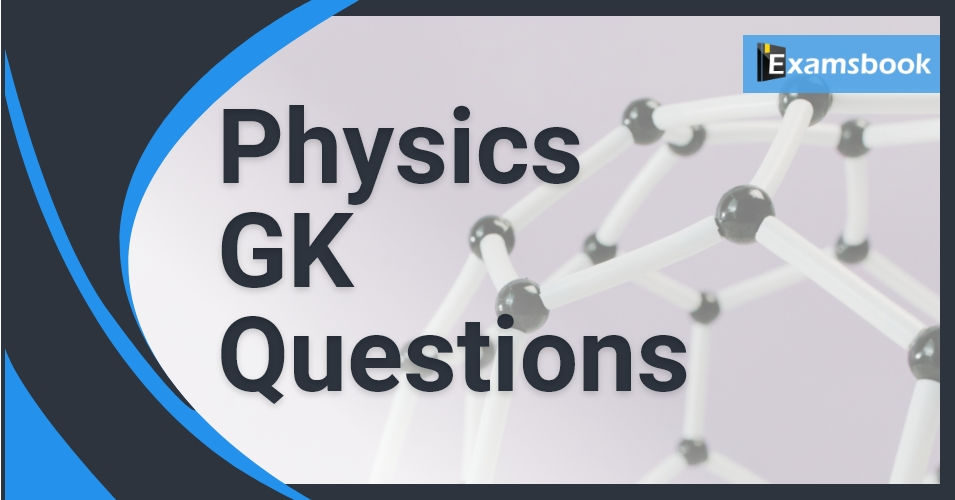Physics General Knowledge Questions: Physics GK Question for Competitive Exams

Physics GK Questions
Q :
When passing through a prism under deflection, which color has the maximum deviation of light?
(A) Red color
(B) Green color
(C) Blue color
(D) violet
Correct Answer : D
Explanation :
If the reflection formed in the mirror is always perpendicular to the object in shape, is the mirror?
(A) concave
(B) convex
(C) level
(D) None of these
Correct Answer : C
Explanation :
When the object moves with speed u towards (or away) from the plane mirror then image also moves toward (or away) with speed u. But relative speed of image w.r.t. object is 2u.
What is the approximate time difference between an actual sunset and a virtual sunset?
(A) 2 minutes
(B) 1 minute
(C) 4 minutes
(D) 3 minutes
Correct Answer : A
Explanation :
As a result, the Sun appears to be raised above the horizon and we are able to see the Sun 2 minutes before the actual sunrise. Same phenomenon occurs during sunset, i.e., we can see the Sun 2 minutes after the actual sunset. Thus, the time difference between actual sunset and the apparent sunset is about 2 minutes.
Which are the two important parts of human beings in which magnetic field must be generated?
(A) arms and legs
(B) muscles and heart
(C) Heart and brain
(D) Eye and visual nerve
Correct Answer : C
Explanation :
Two main organs in the human body where the magnetic field produced is significant, are the heart and the brain. The magnetic field inside the body forms the basis of obtaining the images of different body parts.
Which physical quantity is obtained from the ratio of momentum and velocity of matter?
(A) Velocity
(B) mass
(C) Angular velocity
(D) Acceleration
Correct Answer : B
Explanation :
The correct answer is Mass. Mass is a quantitative measure of inertia, a fundamental property of all matter. It is the resistance that a body of matter offers to a change in its speed or position upon the application of a force. Mass is represented by the ratio of momentum and velocity of the body.
What is the force due to which the body is pulled towards the center of the earth?
(A) mass
(B) impulsive force
(C) Gravity
(D) momentum
Correct Answer : C
Explanation :
Everything is pulled towards center of the Earth because of the force of gravity. Gravity is an invisible pull which attracts the objects towards the center of a planet.
Ice is floating on water in a beaker when the ice melts completely, the level of water in the beaker will be?
(A) will increase
(B) first increase then decrease
(C) will decrease
(D) will remain the same
Correct Answer : D
Explanation :
Therefore, when the ice melts its volume decreases but the volume of water will remain the same. Hence even after the ice melts, there will be no rise in the level of the water. So, the level of the water will remain unchanged.
Light year is a unit of which of the following physical sign?
(A) Short time interval
(B) mass
(C) Work
(D) distance
Correct Answer : D
Explanation :
Light-year is the unit of length to measure large distances (astronomical distances).
The total distance travelled by light in 1 year is called 1 light year.
1 light-year = 9.46 × 1012 km.
Explanation for the incorrect options
The second (sec) is the unit of time.
A kg is the unit of mass.
Therefore, the Light year is the unit of distance. So, option (D) is correct.
According to Dalton’s atomic theory, atoms combine in the ratio of small whole numbers to form ______.
(A) Neutrons
(B) Molecules
(C) Protons
(D) Compounds
Correct Answer : D
Explanation :
1. According to Dalton's atomic theory, atoms combine in small whole-number proportions to form compounds.
Match the columns.
Column - A Column-B
I. Electric current a. Henry
II. Potential difference b. Farad
III. Gapacitance c. Volt
IV. inductance d. Ampere
(A) i-a, ii-b, iii-c, iv-d
(B) i-b, ii-a, iii-c, iv-d
(C) i-d, ii-c, iii-b, iv-a
(D) i-a, ii-c, iii-b, iv-d
Correct Answer : C
Explanation :
The columns are a correct match.
I. Electric current - Ampere
II. Potential difference - c. Volt
III. Gapacitance - b. Farad
IV. inductance - a. Henryd.



